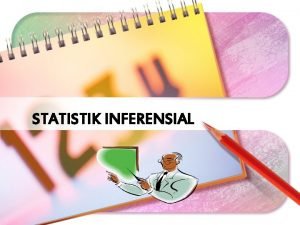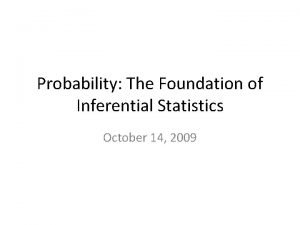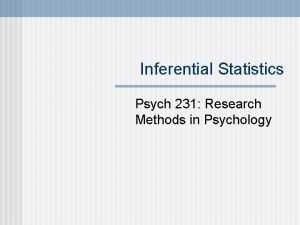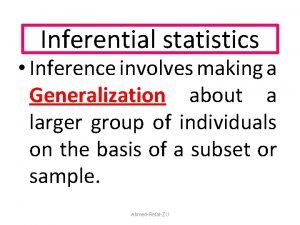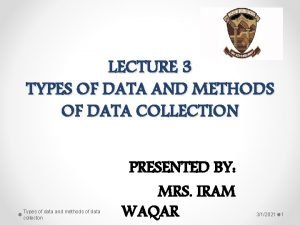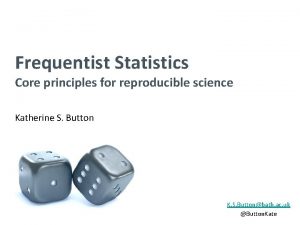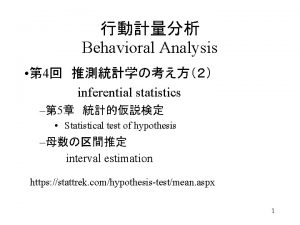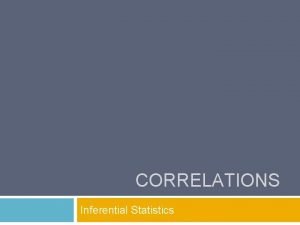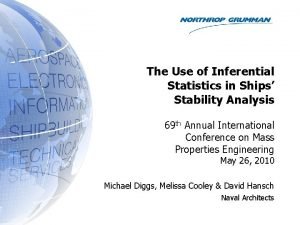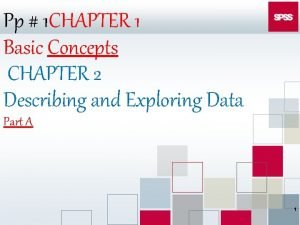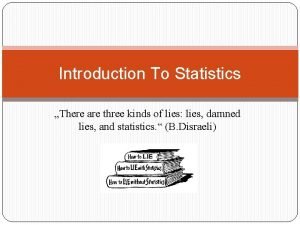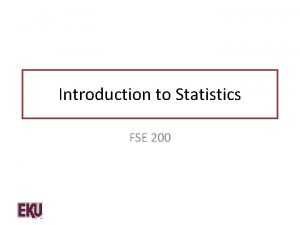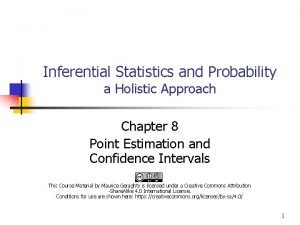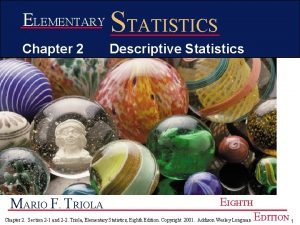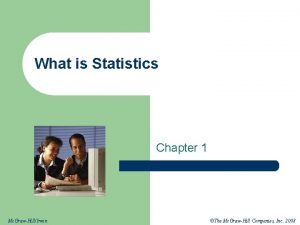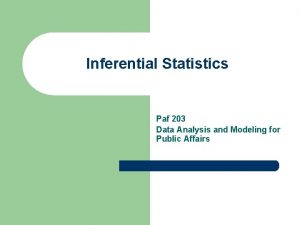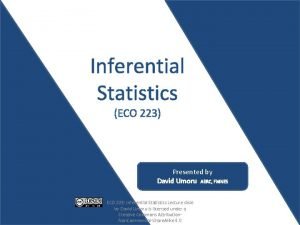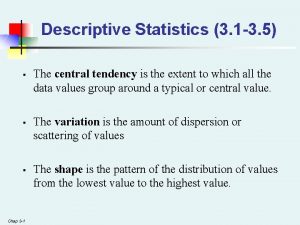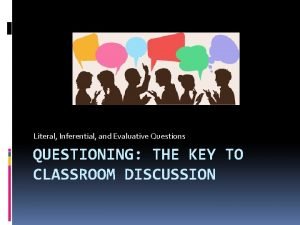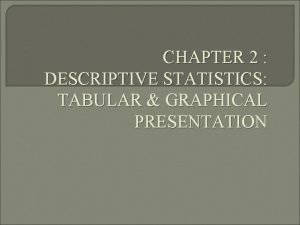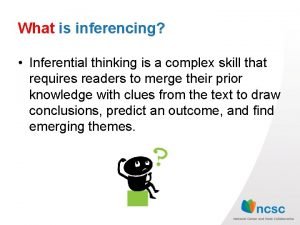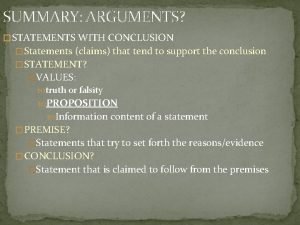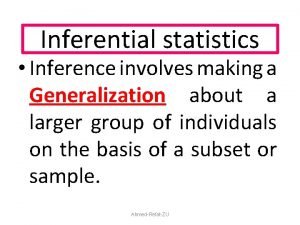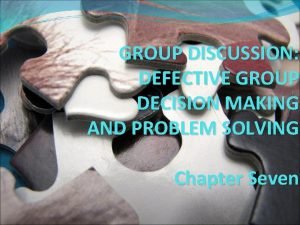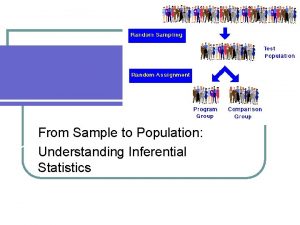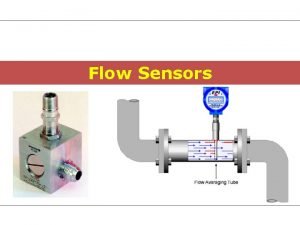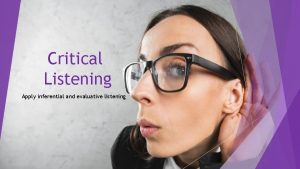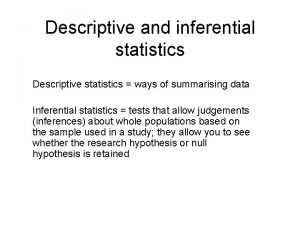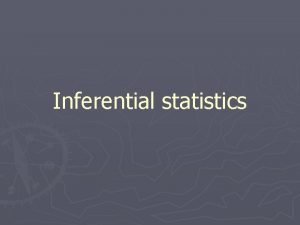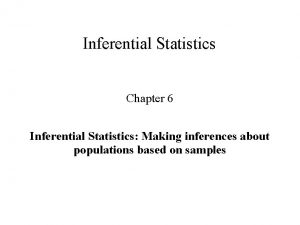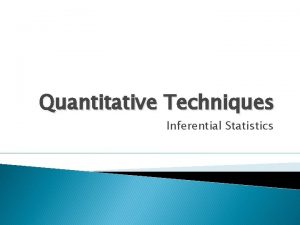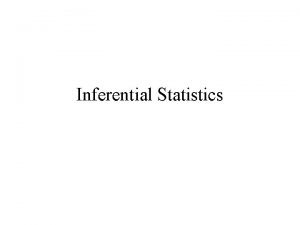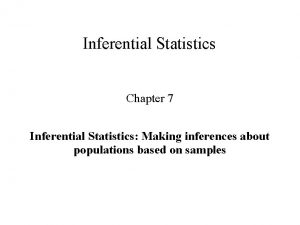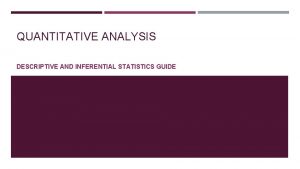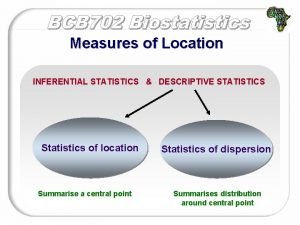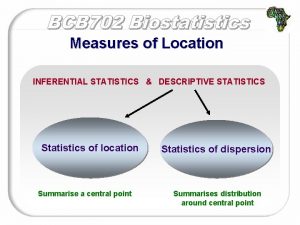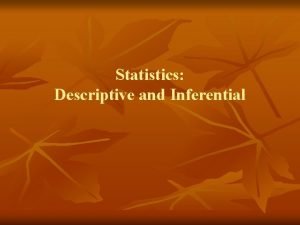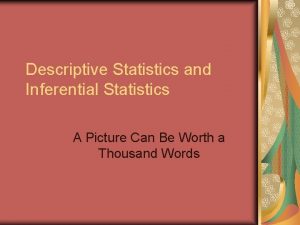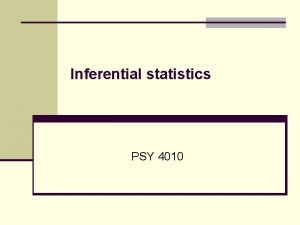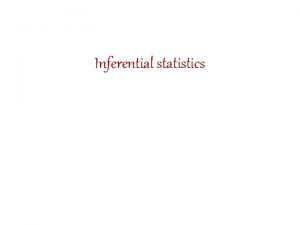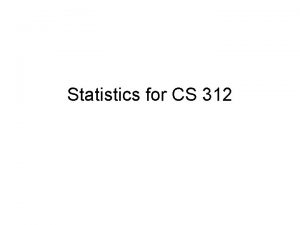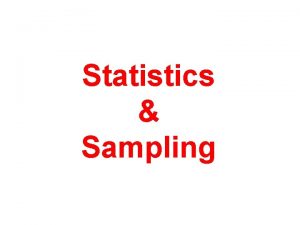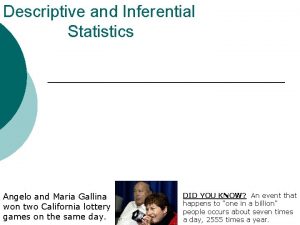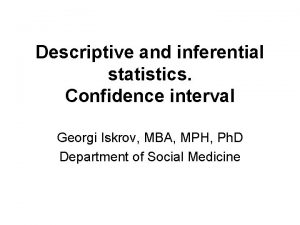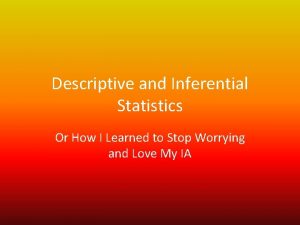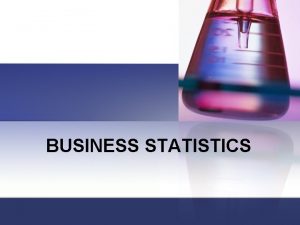Descriptive and Inferential Statistics Descriptive statistics The science































- Slides: 31

Descriptive and Inferential Statistics Descriptive statistics The science of describing distributions of samples or populations Inferential statistics The science of using SAMPLE statistics to make INFERENCES or DECISIONS about population parameters

Inferential Statistics Examples Quantitative (Confidence Intervals) Using sample mean X to estimate population mean μ Using sample stdev S to estimate population stdev σ Qualitative (Hypothesis Testing) Make Conclusions about behavior in population Most widely used inferential statistic

Are these people homeless?

Why are these people so scruffy? Possible Cause #1 • Have homes and lazy owners • Comes from distribution of dogs with homes Possible Cause #2 • Homeless • Comes from distributions of dogs without homes Distribution of Scores People with homes People without homes Less Scruffy More Scruffy These people

Why are these people so scruffy? Distribution of Scores People with homes People without homes Distribution of Means (N=25) People with homes People without homes Less Scruffy More Scruffy These dogs

Hypothesis Testing Cause of Differences • Null hypothesis (H 0) • Alternate hypothesis (H 1) Goal is to • REJECT NULL HYPOTHESIS • Show probability of null hypothesis true as low

Hypothesis Testing When do we reject Null Hypothesis? • When we get an event which is unlikely? • How big is the red area (rejection region)?

Hypothesis Testing When do we reject Null Hypothesis? Rejection Region =. 05 (5%) Why? Why Not? • What if. 50? • What if. 000005?

How do we calculate probabilities of rejection regions? By using different types of distributions! • Single sample Z (easy but uncommon) • T (harder but more common) • F distributions (ANOVA) • Chi-square Distributions (Nominal data)

Hypothesis Testing: Single sample z test How do we reject the null hypothesis 1) Creating a null hypothesis Example: The Mean IQ of UCLA students is 100 H 0: μ=100 2) Creating a distribution of outcomes for H 0: μ=100 Example: A mean distribution (σX=10, , N=25)

Hypothesis Testing: Single sample z test 3) Determine outcomes that we consider “Unlikely” Example:

4) Evaluate if our experimental result is one of those unlikely outcomes Example: (X = 105)

5) Two possible outcomes Reject H 0 X = 105 Fail to Reject H 0 X = 102

Inferential Statistics: Hypothesis Testing If we reject H 0, we have show evidence that it is LIKELY to be untrue. But we might be wrong. How likely is it that we are wrong? Answer: The size of the rejection region = Alpha (α)

Inferential Statistics: Hypothesis Testing If H 0 is true in reality Probability of an error α Probability of no error is α But what if H 0 is not true?

Null hypothesis can wrong in many ways

Null hypothesis can wrong in many ways

Inferential Statistics: Hypothesis Testing If null hypothesis is not true, then Error if Fail to reject =Beta (β) Correct if reject = 1 - β Much harder to calculate than α because depends on how distributions overlap which is affected by Effect Size Sample Size (N) Standard Deviation (σX) Alpha (α) Tails of Test

Hypothesis Testing

two tail (non-directional) No prior evidence Hypothesis can be one tail (right) one-tail (left) (directional) Prior (μ>a) Prior (μ<a) H 0: H 1: μ=a μ NOT =a μ<=a μ>a H 0: H 1: μ>=a μ<a

Hypothesis Testing Errors Type 1 errors: What happens Other researchers use this false result as information Fail to replicate Waste time Type II errors: what happens No research report is created Not much loss to the scientific community Loss to researcher Other researchers can still find the effect

Hypothesis Testing Outline of hypothesis evaluation I. State null and alternative hypotheses II. Set the criterion for rejecting H 0 III. Collect a sample and compute the observed values of the sample statistic and the test statistic IV. Interpret the results

Hypothesis Testing Example Suppose we are interested in the effect of "Absotox" on cognitive ability. Our plan: • select 25 participants • administer Absotox, • Have participants take the Hurlburt Anagrams Test ("HAT"). The score on the HAT is the number of seconds required to solve a series of anagrams. We have used the HAT in many previous studies, and know that in undrugged subjects, HAT scores are normally distributed with mean 90 seconds and standard deviation 20 seconds. Does Absotox affect cognitive ability?

I. State null and alternative hypotheses Variable H 0: µ= 90 sec H 1: µ ≠ 90 sec

I. State null and alternative hypotheses Sample Statistic H 0: µ= 90 sec H 1: µ ≠ 90 sec

I. State null and alternative hypotheses Test Statistic

H 0: µ= 90 sec H 1: µ ≠ 90 sec

II. Set the criterion for rejecting H 0 A. Level of significance? Level of significance =. 05 unless otherwise specified. Therefore zcv = 1. 96 B. Directional or nondirectional? Nondirectional because problem asks whether Absotox affects ability C. Two illustrations of criterion 1. . on sample statistic 2. . on test statistic

III. Collect a sample and compute the observed values of the sample statistic and the test statistic HAT Scores (sec): 95, 106, 75, 118, 99, 127, 79, 20, 109, 101, 94, 91, 121, 94, 97, 94, 121, 105, 111, 135, 71, 73, 108, 65, 119 So X = 2428 Then = X / n = 2428/25 = 97. 12 sec

III. Collect a sample & compute the observed values of sample statistic & test statistic So zobs = ( - μ ) / σ X= (97. 12 - 90)/4. 00 = 1. 78

IV. Interpret the results A. Statistically significant? B. If so, practically significant? 1. Effect size 2. Illustrate 3. Consider C. Describe (plain English) "Because the observed value of the sample mean did not exceed its critical value, or, equivalently, because the observed value of the test statistic did not exceed its critical value, we did not reject the null hypothesis. We cannot conclude that Absotox has any effect on cognitive functioning. "
 Descriptive hypothesis
Descriptive hypothesis T test statistik
T test statistik Empirical method probability
Empirical method probability Inferential tests psychology
Inferential tests psychology Inferential generalization
Inferential generalization Rare event rule for inferential statistics
Rare event rule for inferential statistics Data collecton
Data collecton Inferential statistics
Inferential statistics Inferential statistics 意味
Inferential statistics 意味 Inferential statistics correlation
Inferential statistics correlation Advantages of inferential statistics
Advantages of inferential statistics Characteristics of inferential statistics
Characteristics of inferential statistics Inferential statistics ap psychology
Inferential statistics ap psychology Dichotomic and polynomic
Dichotomic and polynomic Characteristics of inferential statistics
Characteristics of inferential statistics Characteristics of inferential statistics
Characteristics of inferential statistics What are class limits in statistics
What are class limits in statistics Descriptive statistics definition
Descriptive statistics definition Inferential statistics examples
Inferential statistics examples Inferential statistics examples
Inferential statistics examples Descriptive analysis means
Descriptive analysis means Inferential statistics qualitative research
Inferential statistics qualitative research What's your favourite lesson
What's your favourite lesson Evaluative question
Evaluative question Descriptive statistics tabular and graphical methods
Descriptive statistics tabular and graphical methods Inferential thinking adalah
Inferential thinking adalah Simple non inferential passages
Simple non inferential passages Inferential generalization
Inferential generalization Defective decision making
Defective decision making Inferential test types
Inferential test types Obstruction meter
Obstruction meter What does critical listening mean
What does critical listening mean

